Beautiful drawings on cells include inscriptions and images of varying degrees of complexity. Now this entertainment is associated not only with a sheet of paper from a school notebook, but also with computer games - for example, coloring books.
However, only real creativity with paper and pencil gives the opportunity not just to have fun, but to develop useful skills. Also, all types of drawing calm with their monotony, and a quick and beautiful result motivates for further creativity.
Tools for drawing pictures by cells
The beauty of a drawing or inscription on cells largely depends on the tools and materials.
Paper should be selected based on the following parameters:
- Density. Newsprint is not suitable for pixel images, as the image will show through on the other side and it will be impossible to color the cells well. A fairly thick paper with a marking of 70 - 80 g / m is ideal.2.
- Whiteness and brightness of the cell. If the color of the paper is not of great importance, then it is worth paying attention to the degree of drawing of the cells. It is better to choose a notebook in which the cells are clearly visible, but they are not printed with bright paint. So that it is easy to count the cells, but at the same time the boundaries of the cells are not visible through the color when painting.
- The more complex the image, the larger the sheet of paper should be. – for this purpose, A4 notebooks and squared exercise books or special graph paper are suitable.

There are many tools that can be used when drawing by cells:
- Colored pencils - soft or semi-soft.
- Wax crayons - well sharpened.
- Felt-tip pens, liners, highlighters.
- Simple pencil.
- Ballpoint or gel pens.
All tools have their pros and cons. For example, felt-tip pens allow you to create a very bright drawing, but they show through the sheet and can leave stains or even holes in the drawing if you stop your hand or press too hard.
Gel pens give a bright soft line, but the image is easy to smudge. Some of the difficulties can be solved with auxiliary tools and materials: a white eraser, correction fluid, and a blotting sheet.
Simple lettering on cells for beginners
Drawings on cells, inscriptions and images have their own specifics.

In order to create simple inscriptions in Russian or any other language, you do not need to remember how all the letters are written, how many cells they consist of, or exactly redraw the sample.
It is enough to master the basic principles of composing inscriptions in cells. All letters consist of 4 elements: straight line, diagonal line, circle, semicircle. These are the segments that you need to learn to make from cells.
A circle in pixel art turns into a square with or without corners, and a diagonal into steps of cells. For training, you can take your name or a word in which all the elements are found.

Next you need to act according to the following algorithm:
- You need to decide what size the letters will be. It is better to choose an odd number of cells for the height (5,7, 9 and more), so that it is clear where to make the middle. The width of a standard letter should be at least 4 cells, otherwise it will be impossible to build a crossbar at the "i".
- Next, it is most convenient to mark with dots those cells that will be painted. An insecure artist can do this at first with a thin simple pencil, and not with the main color.
- After this, step by step, the cells in which the dots are placed are outlined and painted. It is more convenient to outline the cells in groups.
- If the entire inscription is painted in one color, then you can highlight some edges and corners of the letters with a contrasting color (for example, red for black).
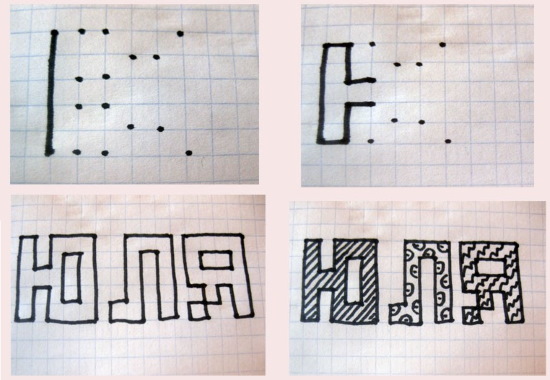
The silhouette of the inscription can be changed if the letters are not supposed to be painted over entirely. In this case, more empty space is needed inside, and the oval turns into a rectangle, and the semicircle into a square, i.e. the corners are preserved.
For such letters you need to complete the following steps:
- At the initial stage, dots are not placed in the center of the cells, but the corners are marked with dots and segments are drawn between them.
- The resulting letters can be filled with a colored or black ornament. If you use only one color, an interesting solution would be to cover each letter with its own pattern - for example, it could be hatching, circles, zigzags.
Such an inscription in cells can decorate not only a notebook or personal diary, but also a poster or a postcard.
Inscriptions on cells in English
The inscriptions on the cells can be made not only in Russian, but also in any other language. There are many ready-made fonts. In English, abbreviations of words are often used in pixel sketches.
| Reduction | Transcript |
| U | you |
| 4U | for you |
| B4 | before |
| GF | girlfriend |
| M.U. | I miss you |
| LOL | laughing out loud |
| HAND | Have a nice day |
| 10x | thanks |
| X | kiss |
| XOXO | Hugs and kisses |

Using abbreviations (acronyms) and numbers allows you to reduce the length of the inscription. Also, words made in cells are often supplemented with pixel drawings.
Letters in cells according to your own sketch
Drawings on cells (inscriptions of all types and pictures) have many admirers. At the moment, ready-made samples of all fonts in pixel execution have been developed, but you can also make an original inscription based on your own sketch.
Making such an inscription involves several simple steps; you can start the training with your initials:
- First, determine the size of the letters. The larger the inscription, the more complex and interesting the letters can be. The ideal size will be no less than 11 cells.

- Next, use a simple pencil to make a sketch of the letter. The lines should be very thin, barely noticeable. The letter can contain any curls, but it is better to avoid very sharp elements and the contact of several lines.
- After that, the cells where the lines are are marked with dots; if the line is on the edge of a cell, the author himself chooses which cell to put the dot on. If the line touches 2 cells at once, then dots can be put on both cells.
- Once all the dots have been placed, you can begin to outline the cells in groups.
- Next, the cells are painted with the chosen color. In this case, red and black.
- At the final stage, you can make a shadow in some places by drawing a row of cells with a simple pencil.
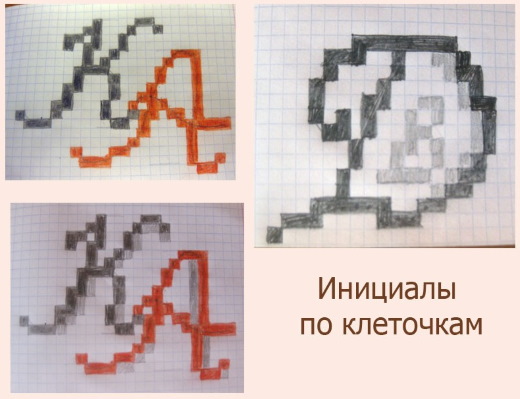
Such initials can become a decoration of a notebook, a personal diary or even become a pattern for cross-stitching. This is not only a useful but also an exciting activity, since the result is different each time.
Volumetric letters by cells
One of the varieties of inscriptions on cells are volumetric letters. It is better to make such letters no less than 7 - 9 cells in height with a width of no less than 6 cells, respectively. The thickness of the letter elements should also be no less than 2 cells, otherwise it will be difficult to draw the volume, and there will be no room for the internal decor of the letter.
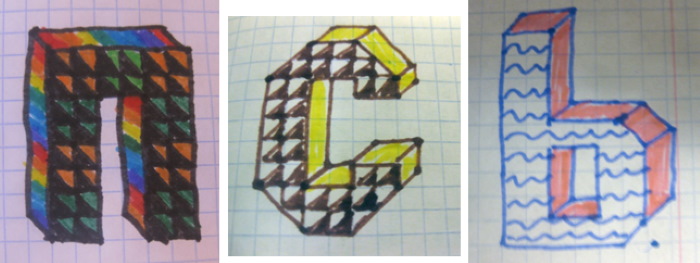
All letters can be divided into several groups with similar elements:
- Letters in which straight lines predominate: p, n, g, i, t, sh, shch, e.
- Letters with slanted elements: a, l, m, d
- Letters based on a circle and a large semicircle: o, yu, s, e.
- Letters based on a small semicircle: z, ь, б, ъ, р, ф, в, ы.
- Letters with diagonal sticks: k, ya, zh, h.
Drawings on cells, especially inscriptions, are attractive due to their simplicity. It is enough to master one of the letters of the group to be able to draw others. You need to start learning with the simplest letters, consisting of straight lines - "p", "t", "g".
For example, training with the letter "p" occurs according to the following algorithm:
- First, you need to draw the silhouette of the letter. You need to decide how thick it will be, whether it will have cut corners, whether it will be tilted. The letter can take any form, but a beginner should choose the simplest option.

- Next, you need to draw the volume - for this, draw a diagonal from each corner through 1 cell (you can make it wider). Before making the letter three-dimensional, you need to decide from which side the eye falls on it, this determines which side edges are visible.
- Then I finish drawing the horizontal and vertical lines of the side edges.
- For practice, you can draw 4 identical letters and give them volume by changing the angle of view (the arrows in the picture show the direction of view).
- The next step is to color the letters. You can try different decoration methods on the 4 existing letters.
The easiest way is to not color anything or fill only the edges of the volume with color. The second option is to completely color the sides and make a simple pattern on the surface of the letter with the same color - for example, hatching, waves or zigzag. This method is well suited for children.

The third option is to make the side edges and the main pattern of the letters in contrasting colors. The ornament can be created based on cells. First, draw a grid, and then fill each cell with the same or alternating pattern - these can be dots, strokes, or a regular checkerboard.
You can also leave the letter in black and white, then you can apply a complex pattern to the surface - for example, consisting of fragments of 4 cells, in which the pattern is repeated.
- Then you can practice drawing other letters from the same group, varying the thickness of the elements, the angle of view, trying different patterns.
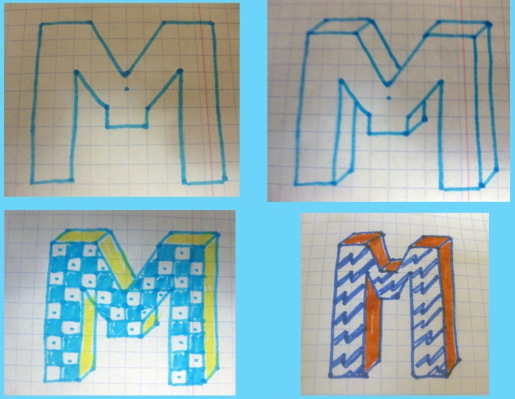
Having learned to add volume to simple letters by changing the direction of your gaze, you can move on to more complex symbols. It is important that each new stage of work brings some new skill. For example, when working on the letter “m” or “a”, you can try to create several different options – by thickness, by the shape of the middle part.
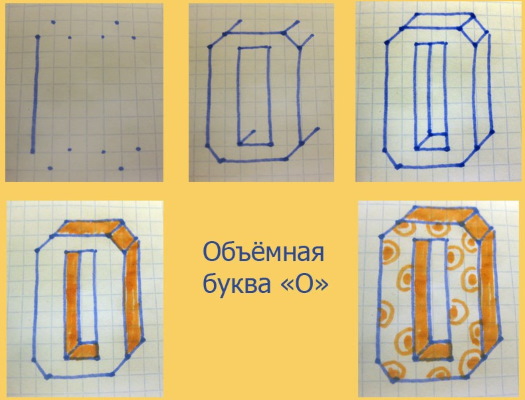
When practicing drawing round letters, it is interesting to try different degrees of rounding (cutting corners). You can also change the size and shape of the inner hole.
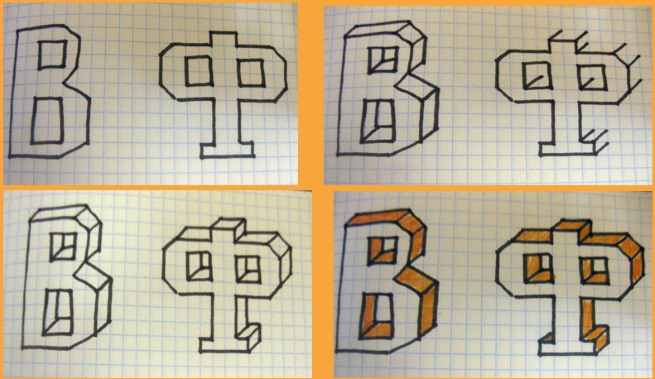
When working on letters from the "ь" group, special attention should be paid to complex letters that include several semicircles - "в", "ф". For these letters, you need to clearly define the direction of the view and build a diagonal from each corner point. These lines should not go beyond the main field of the letter. Small side corners are often lost, but they are also important for adding volume.
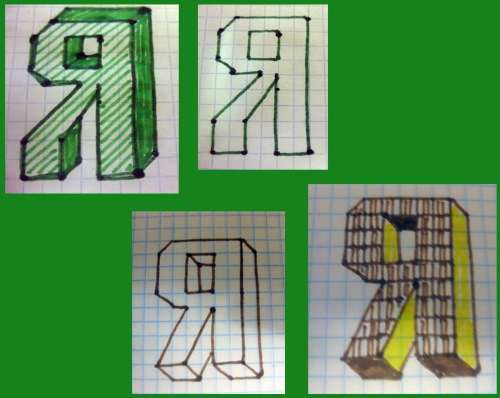
When drawing letters from the "k" group, you need to pay attention to the fact that diagonal elements can be built in different ways. This can be seen in the example with the letter "ya". After practicing several volumetric letters, you can make an original inscription for a poster or collage.
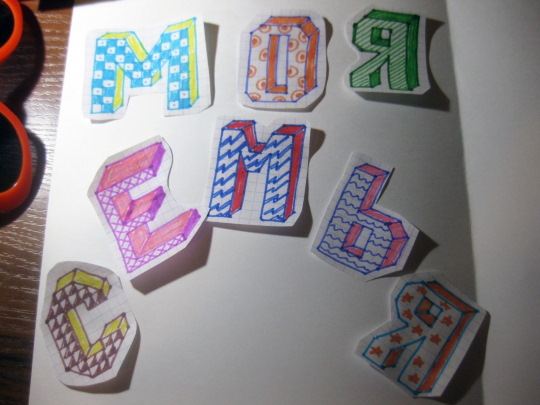
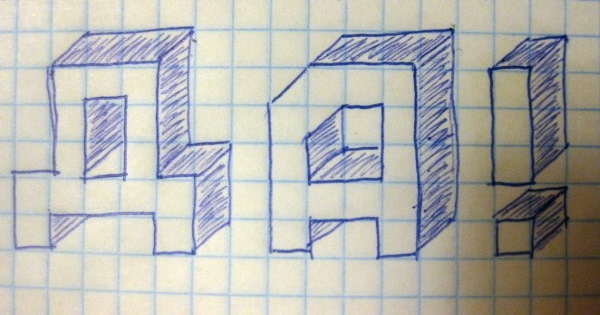
Children have the opportunity to make a collective project, creating a three-dimensional proverb or alphabet with the whole class. It is not necessary to use the whole range of tools, three-dimensional letters made in one color with a simple pencil or ballpoint pen also look interesting.
Simple drawings by cells
Lettering is not the only type of cell creativity; cells can be used to create drawings of varying levels of complexity.
This:
- Monochrome images (black and white or including different shades of gray).
- Colored images with dark outlines.
- Fully color images.
Drawings on cells, inscriptions and pictures have their own characteristics. To get acquainted with them, you need to choose several simple samples and start drawing.
Master class – drawing on cells “Frog in love”
Using this funny little frog as an example, you can master the basic subtleties of drawing by cells, and at the same time make a pleasant surprise for a friend or child by decorating his notebook or album.
Instructions:
- If you want to create your own drawing by cells, rather than copying a ready-made version, then you need to first make a sketch, roughly outlining the sizes and colors.
- Then you need to mark with a pencil where the drawing will be located.
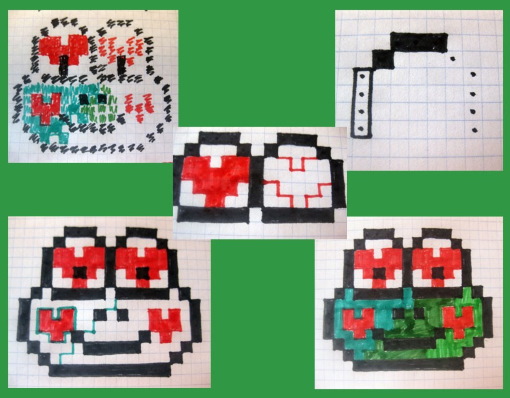
- Drawing begins with black outlines, from the very top edge, that is, from the eyes. The cells that will be painted are marked with dots.
- Then all the marked cells are outlined in black, in groups.
- Color the cells evenly, without pressing hard on the felt-tip pen or pencil.
- If the figure is simple, such as a pupil in the shape of a heart, then you can no longer mark the cells with dots, but immediately make a silhouette.
- When all the black cells are painted, make red cheeks in the shape of hearts.
- After this, you need to paint the entire area of the head green. In order not to accidentally go over the red color when shading, you need to outline the red field with green first, and then start painting the large area.
- An interesting solution would be to combine several shades of green. It is better to move from color to color not in a straight line, but by dividing the cells with a ladder, as if modeling a gradual transition. The same technique is used to depict shadow or volume (for example, when drawing fruit).
Creating complex designs using cells
Pixel art technology allows you to transfer not only primitive images to paper. You can copy the image of your favorite cartoon character or even a family photo.
For drawing on cells, it is better to choose clear photographs or pictures with a small number of details. The more complex the image, the larger the sheet will be needed, or you will have to draw on graph paper.
To transfer the image to paper, you need to install Photoshop on your computer, and then follow this plan:
- First, you need to find an image or photo that you want to copy.
- Next, you need to open this picture in Photoshop (File – Open).
- If the image is small, it is better to enlarge it in the Image tab – Image size.
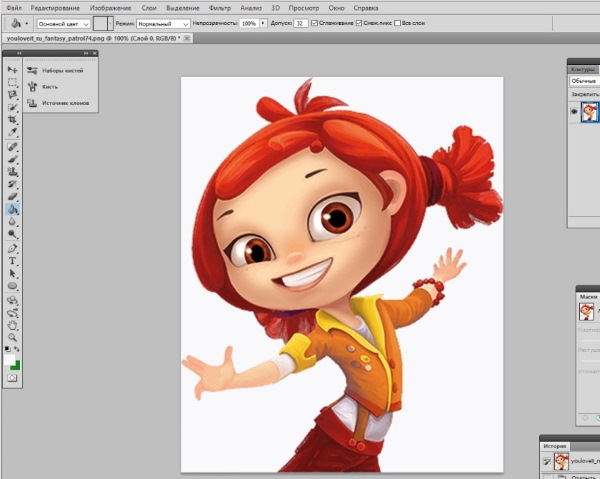
- Next, you need to go to the menu Image – Correction – Posterization.
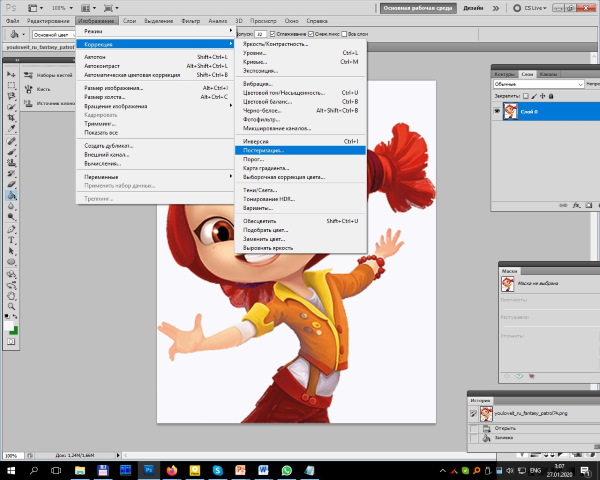
In the dialog box, you need to set the simplification level using the slider. The lower the value, the fewer color shades will remain in the image. The best option is to stop between values 4 and 7.
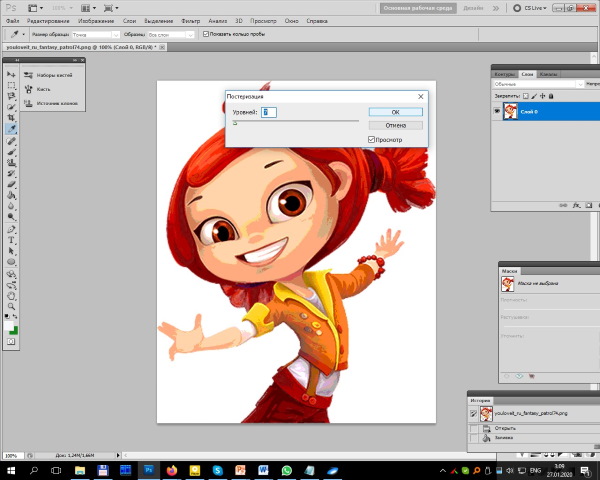
- After optimizing the color scheme, go to the menu Filter – Design – Mosaic. In the drop-down window, you need to determine the size of the square – the higher the value, the larger the squares.
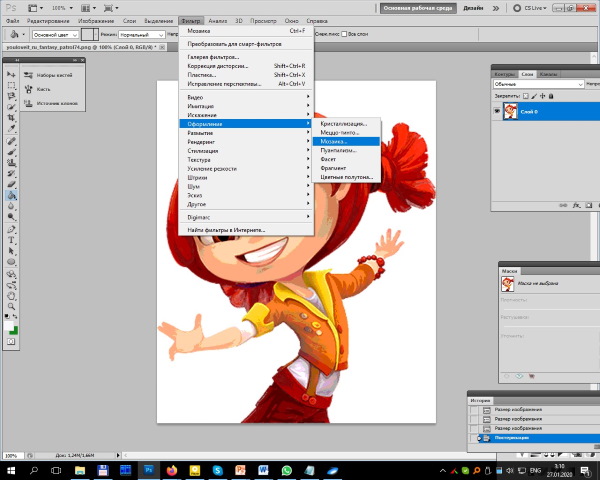
It is best to take the range - 4 - 10. The result is an image divided into cells.
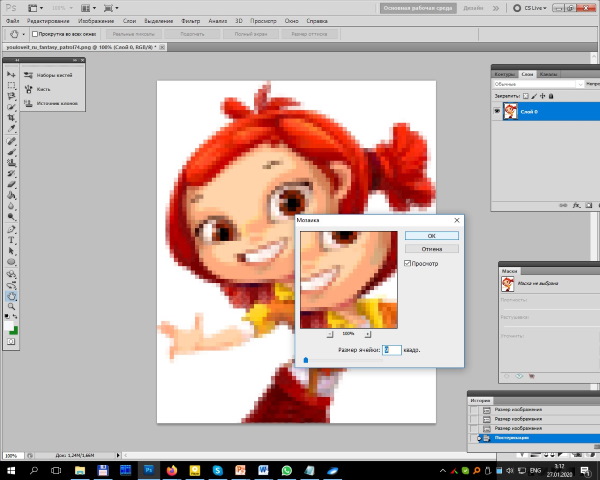
- To make sure the cells and colors are not blurred, you need to apply the filter - Sharpening in different versions and enlarge the image.
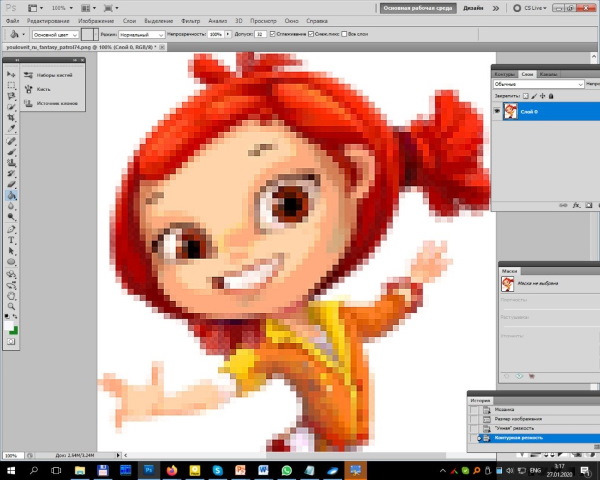
- To make it easier to transfer the image to paper, you can divide it into sectors of 10-15 cells. This can be done using the Line tool.
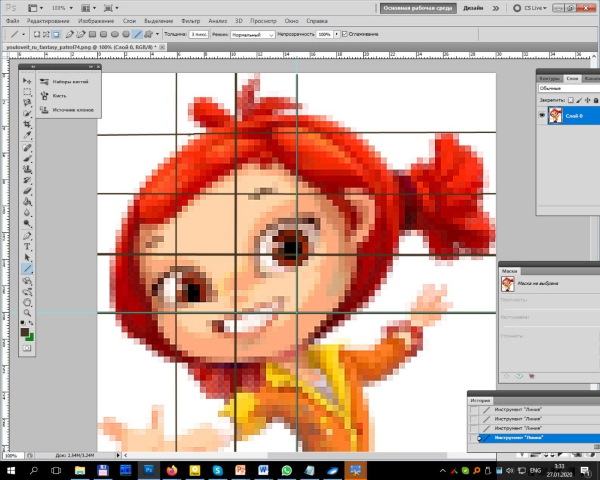
- Next, you can print the image or copy it from your computer monitor. To maximize the cells and make the work easier, you can use the View – Enlarge menu.
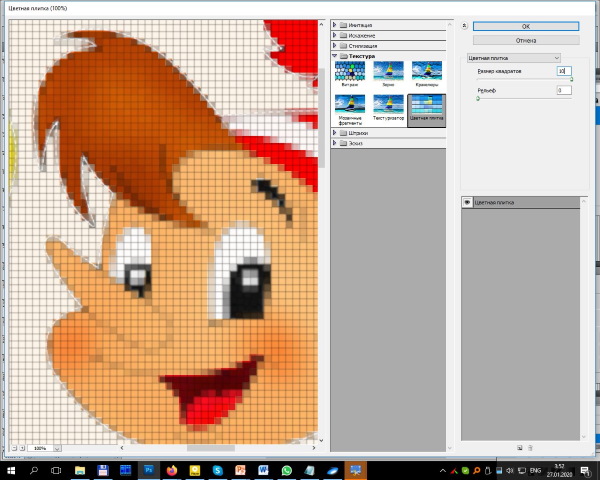
A similar algorithm is used to create your own cross stitch patterns. The same operations can be performed using other Photoshop tools: filter – Filter Gallery – Colored Tile (with squares of 10-20, and relief – 0).
Drawing by cells with children
Drawings by cells (inscriptions and pictures) have enormous developmental potential.
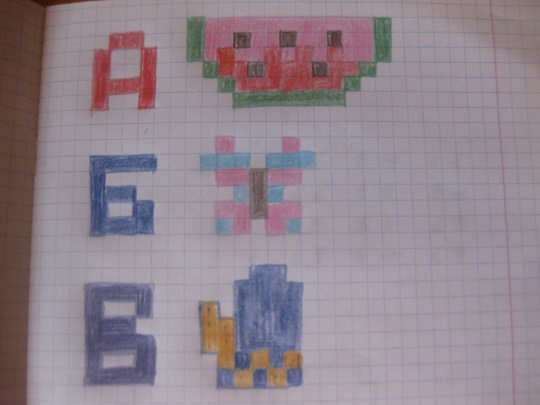
Besides being a very exciting activity, pixel art helps develop many skills in children:
- Ability to count.
- Ability to paint accurately.
- Ability to draw straight lines.
- The ability to see cells.
- Ability to copy an image.
This type of drawing can be practiced with children starting from 3-4 years old.
With older preschoolers and in primary school, you should try the whole range of educational tasks:
- Copying simple drawings by cells.
- Completing half of the picture to the whole, cell by cell.
- Copying and coloring simple letters and drawings on cells. Creating a pixel alphabet.
- Graphic dictations – letters and simple drawings, shading of the resulting images.
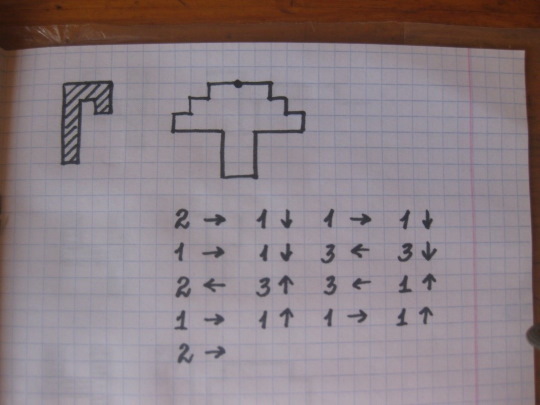
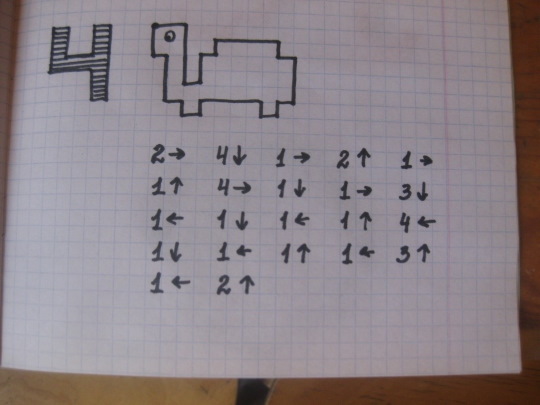
Drawing on cells is interesting not only for small children, but also for teenagers and adults. Such creativity is ideal for decorating personal diaries, notes and summaries. This process calms, gives a break and allows you to express your individuality. And most importantly, a quick and beautiful result gives a positive charge.
Several options for decorating notebooks and diaries:
- Rainbow wall of positive diamonds and other shapes.
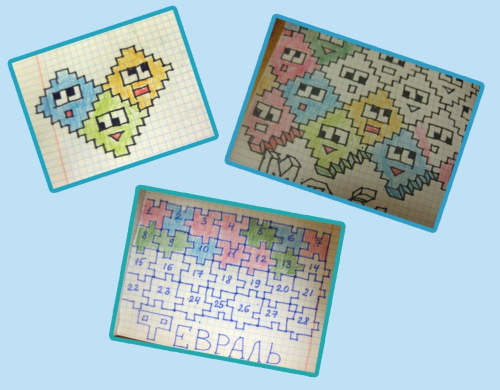
- A personalized calendar made from Lego bricks, Tetris, or puzzle pieces. You can come up with a color code for different activities (e.g. blue for swimming pool, yellow for dancing). You can also paint the segments in different colors depending on your mood or the weather (positive for yellow, negative for black).
- Creating braids and ornaments on the fields. Repetition and creation of intricate braids turns into an exciting competition for schoolchildren.
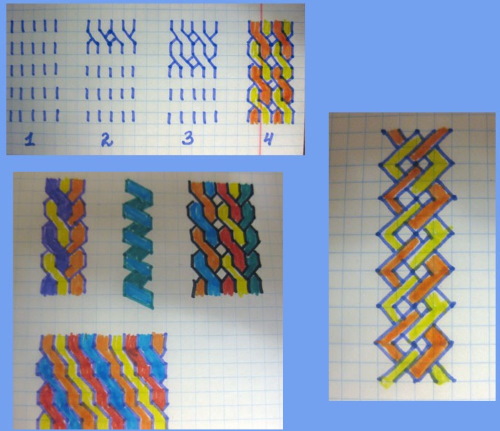
- Drawing pixel smileys. This is one of the ways to express your mood in a notebook, the smiley can be supplemented with a corresponding inscription.
An old pastime, drawing on cells still successfully competes with virtual applications. Pixel inscriptions, ornaments, volumetric letters and intricate braids look so bright and original that they make people of different ages want to try to do something similar.
Author: Pichugina Stanislava
Video about drawing by cells
Drawings by cells of the inscription:
